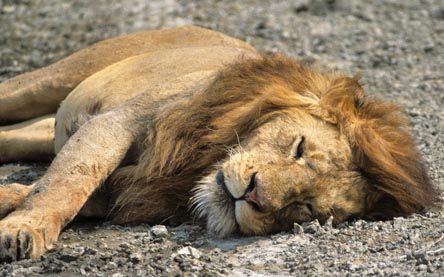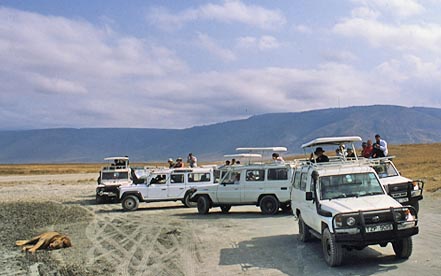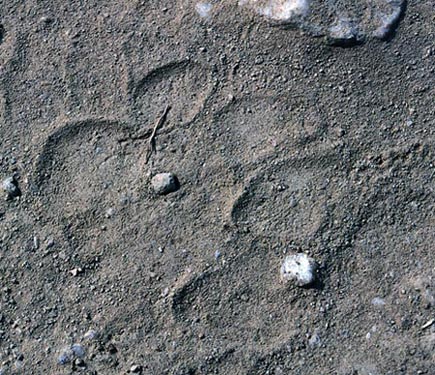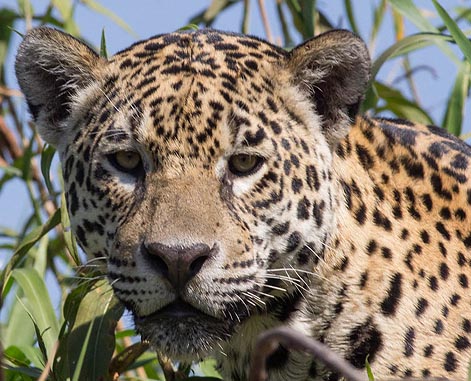
a web page by Don Roberson |
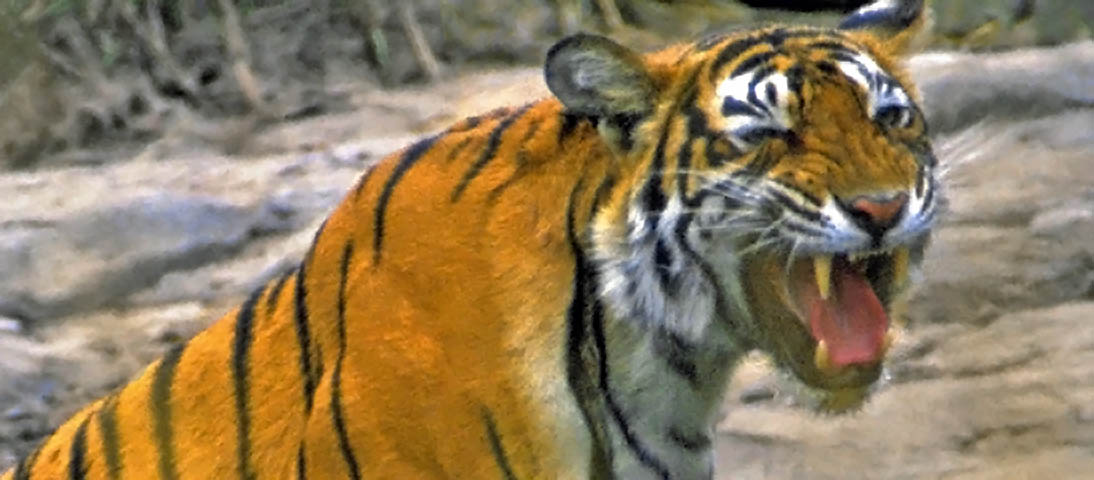 |
||||||
Tiger in March 2001 at Ranthambhore, India © Don Roberson (above) |
||||||
|
||||||
In traditional terms, Tigers have been split into 8 subspecies (3 of them now extinct) but recent genetic studies have found little evidence to support this level of differentiation (Sunquist & Sunquist 2009). For most of us, the best chance to see a wild tiger is in India or Nepal, where the population involved is called the Bengal Tiger (the nominate subspecies P. t. tigris). It is the most common remaining Tiger population and yet it is endangered, with estimates of less than 2500 adults. For the most part the remnant populations are limited to a few Tiger reserves and National Parks. When Rita and I and two friends visited India in 2001, we structured our trip for the March dry season when chances to see Tiger would be at their highest. We were lucky to have good success, seeing Tigers on 3 of our 4 game drives in Ranthambhore: a total of four different individuals (one large male seen on two drives, one young male, and two females, one of which was in heat and calling). Note, though, that we missed it during one half-day drive in prime time and habitat — one should not rely solely on a one-day visit to a reserve if seeing a Tiger is priority! Late in our trip another male crossed the track in front of our jeep on the final stretch of the last day's drive in Kaziranga NP, Assam, India — a truly unexpected wild tiger. It dashed into a roadside bush (flushing up our only Chestnut-capped Babbler Timalia pileata of the trip!) and then stuck its head back out to look at us in what Dan Singer called the most memorable moment of the trip. |
||||||
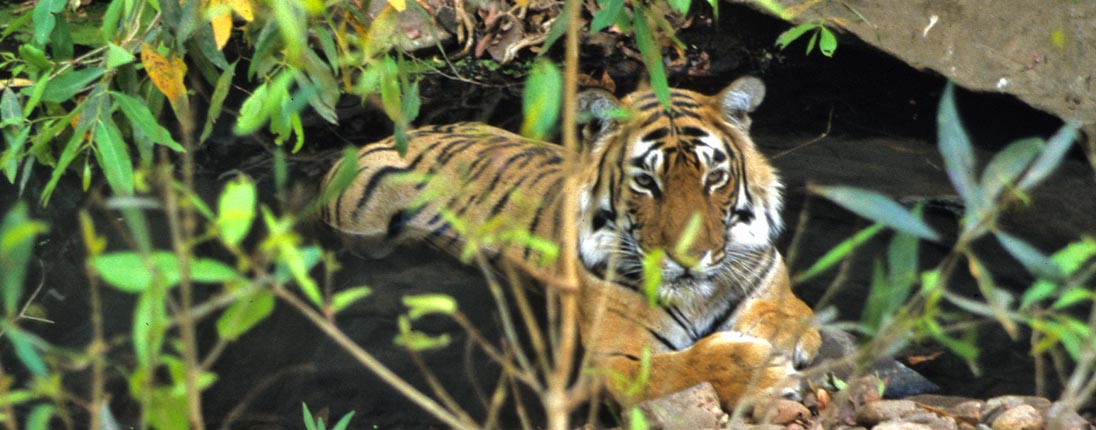 |
||||||
Tiger in March 2001 at Ranthambhore, India © Don Roberson (above) |
||||||
Lion on 6 Aug 2002 in Tarangire NP, Tanzania © Don Roberson (below) |
||||||
 |
||||||
Until the late Pleistocene, Lion Panthera leo was the most widespread large land mammal on earth (after humans), ranging across much of the Old World. With the end of the ice ages, humans have spread further. Lions have declined. Today they exist only in sub-Saharan Africa, with a tiny population still in the Gir Forest of India. In Monster of God (2003), it was the Gir Forest lions and their interactions with local villagers, that Quammen explored. While lions do not typically hunt people, some have sought human prey. In the well-publicized case involved the "Tsavo man-eaters," perhaps 50 or so workers building the Kenya-Uganda Railway were eaten by lions during the construction of a bridge over the Tsavo River in Kenya in 1898 (Patterson 2004; in the 1996 film The Ghost and the Darkness the attacks are attributed to two brother lions). The record for man-eating is not the Tsavo brothers, but a entire pride in what is now Tanzania during the early 1930s through the late 1940s. Three generations of lions are thought to have eaten 1,500 to 2,000 people (Rushby 1965). Even in recent years, it is estimated that 200 Tanzanians are killed each year by lions, crocodiles, elephants, hippos, and snakes, and that the numbers could be double that amount, with lions thought to kill at least 70 of those; Packer et al. (2005). Lions have attacked people even within large villages. A study of 1,000 people attacked by lions in southern Tanzania between 1988 and 2009 found that the weeks following the full moon (when moonlight declines) were correlated to increased night attacks on people; Packer et al. (2011). On the other hand, researchers have lived with lions for years without being attacked [e.g., Mark & Delia Owens's work in Botswana (1985)], and there is context between lions, prey, and people that depend on location and circumstances. Hordes of tourists observe lions peacefully among the great National Parks of Africa. |
||||||
|
||||||
| Still, there is something unsettling just being in "lion country." During apartheid, many Mozambican refugees crossing the border into Kruger National Park, South Africa, were killed at night by lions; Frump (2006). Rita and I spent most of a week in Kruger NP in post-apartheid South Africa in 1996. One is required to stay within your car at all times when driving in the park — except for designated picnic areas and camps — for one's own safety. We enjoyed following some roads away from the main tourist drives, and occasionally one does need to stop to answer the call of nature. After doing so one morning, we got back in the vehicle and turned the very next corner to find these two lionesses standing in the middle of the road (true story; below). It is wonderful to be close to nature . . . but perhaps not too close. | ||||||
 |
||||||
Lions July 1996 in Kruger NP, South Africa © Don Roberson (above) |
||||||
Leopard Aug 2002 in Tarangire NP, Tanzania © Don Roberson (in tree at dusk, below) |
||||||
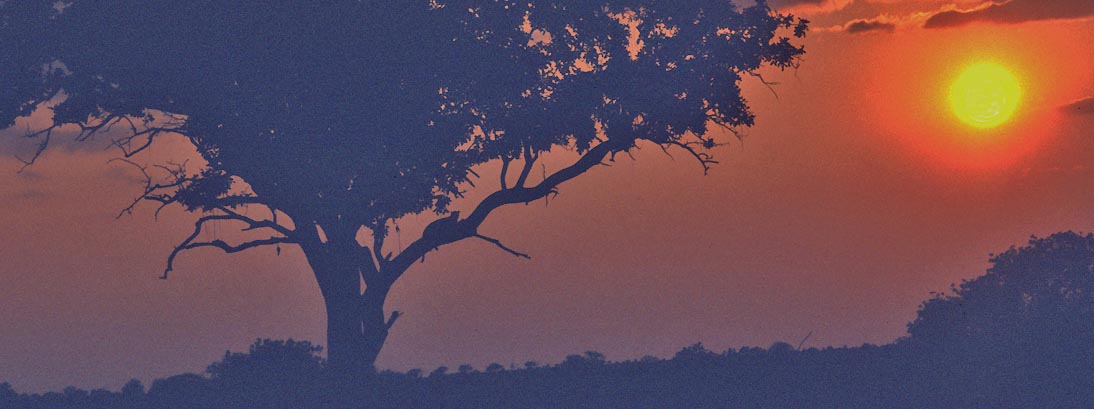 |
||||||
In Man-Eaters of Kumaon (1946), dealing with the situation in India, Jim Corbett wrote that "in the case of human beings killed by carnivora, the doubt is often expressed as to whether the animal responsible for the kill is a tiger or leopard. As a general rule — to which I have seen no exceptions — tigers are responsible for all kills that take place in daylight, and leopards are responsible for all kills that take place in the dark." So it is the Leopard Panthera pardus that, in Asia at least, is the alpha predator of the dark. In Africa, lions and hyenas both hunt after dark, so there is more competition. Tiger and Lion are endangered, but Leopard is not. The Leopard's success as a species is due to "its opportunistic hunting behavior, its adaptability to habitats, its unequaled ability to climb trees when carrying a heavy carcass, and its notorious ability for stealth." It is the great generalist of the big cats, and it ranges from rainforests to deserts. Leopard Panthera pardus is a distinct species. Once divided into as many as 24 subspecies, recent genetic evidence essentially reduces that named diversity to three major clades — African, Indian, and Central Asian — with isolated subspecies from Southeast Asia and China to Java (Sunquist & Sunquist 2009). Leopard should not be confused with Snow Leopard Panthera uncia or the two species of Clouded Leopards [Indochinese Clouded Leopard Neofelis nebulosa and Diardi's Clouded Leopard N. diardi], none of which are man-eaters. |
||||||
|
||||||
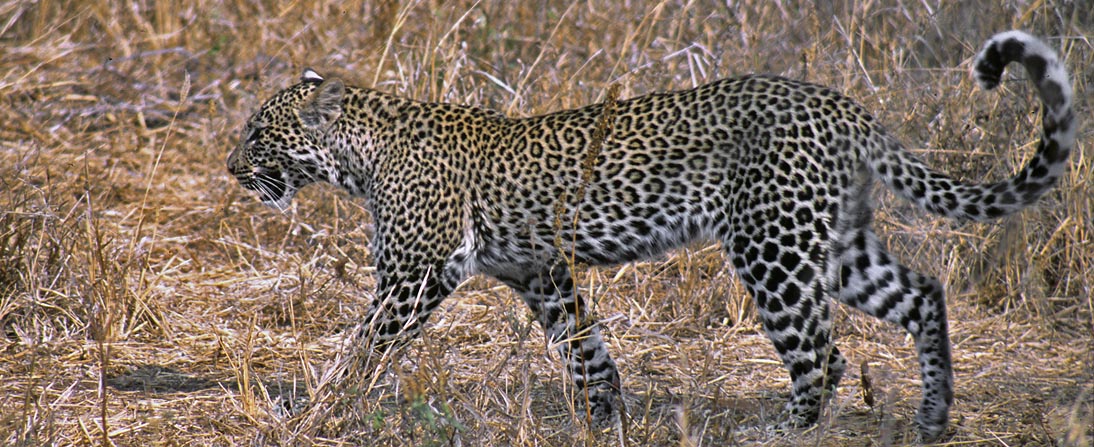 |
||||||
Leopard on 5 Aug 2002 in Tarangire NP, Tanzania © Don Roberson (both photos above) |
||||||
Jaguar on 22 July 2010 along Rio Cuiabá, Brazil © Don Roberson (below) |
||||||
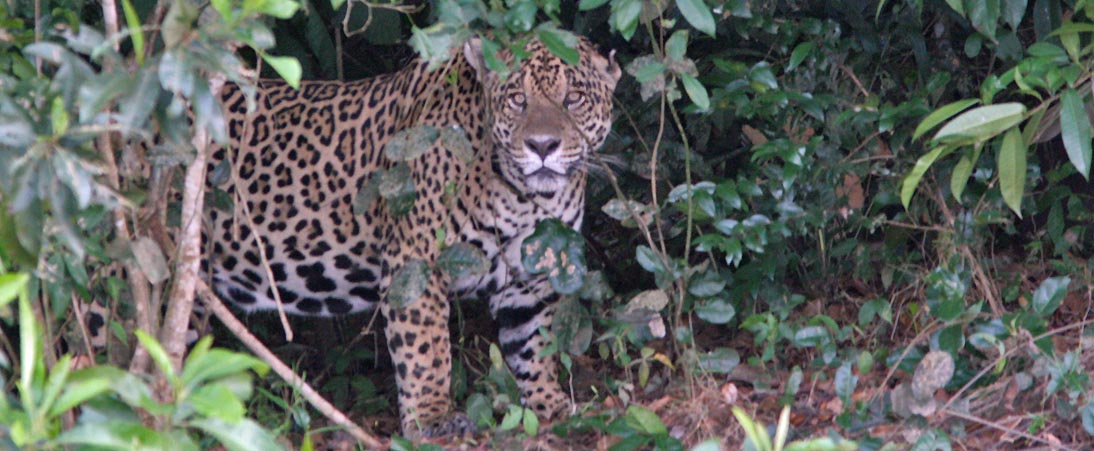 |
||||||
Jaguar Panthera onca is the third-largest cat in the world (after Tiger and Lion) and is the alpha predator of the Neotropics. It has a huge range from Mexico (and rarely in the southwestern United States) to northern Argentina, and uses habitats from dense lowland rainforest to the open Pantanal wetlands. As a spotted cat it may recall a Leopard, but has more complex rosettes across its sides and back; is usually larger and of sturdier build; and has a broader head and neck. Some have pointed out that its behavior is closer to that of a Tiger. It is strongly associated with the presence of water and is, along with Tiger, a cat that enjoys swimming. Jaguar is a compact and well-muscled cat; males are substantially larger than females. Larger males have been recorded to weigh as much as 160 kg (350 lb), roughly matching a Sumatran Tiger or a lioness. Jaguars in the Pantanal are the largest of the Jaguars, about 50% larger by weight than those in the Amazon and about 100% larger than those in northern Middle America. Recent genetic work indicates there are only two major populations — one from Mexico to northern South America, and the other from Peru and Brazil south through the Pantanal — rather than nine subspecies as previously thought (Sunquist & Sunquist 2009). Jaguar is largely a solitary, opportunistic, stalk-and-ambush predator at the top of its food chain. It plays an important role in stabilizing ecosystems and regulating the populations of the animals it hunts. Jaguar is a stalk-and-ambush rather than a chase predator. The cat’s ambushing abilities are considered extraordinary by both indigenous people and field researchers. |
||||||
|
||||||
It is generally thought that Jaguars rarely attack humans, and (like Tigers and Leopards) many such attacks were by cats that were either old, wounded, or had damaged teeth. Further, some attacks are defensive. Researcher Paul Donahue was once charged by a Jaguar when he inadvertently approached too closely to the large cat eating its prey. A Jaguar can easily kill a person, and occasionally does. Donahue advises that there have been three relatively recent attacks in their Pantanal research area: "The first was when a mother and nearly full-grown cub ripped into the tent of a sleeping fisherman and ate him. The father of the deceased subsequently went on a rampage, killing about 15 Jaguars in retaliation. In the second incident a Jaguar leapt into the boat of a local fisherman and attacked him. The fisherman escaped, but with a serious bite to his face. The third and most recent incident again involved fishermen. Three sport fishermen were fishing from a boat anchored fairly close to shore. Two were facing one direction while the third was facing the other way. The two felt a movement and looked around to see that a Jaguar had swum up to the boat, reached up and snagged their companion and was making off with him. They grabbed paddles and began beating the Jaguar over the head — fortunately saving their friend's life." |
||||||
Jaguars have the most powerful bite of any of the cats, even more powerful than the larger Lions and Tigers. This allows it to pierce the shells of armored reptiles and to employ an unusual killing method — it may bite directly through the skull of prey between the ears to deliver a fatal bite to the brain. Alternatively, the powerful bite may go to the neck or brain-stem. Paul Donahue’s photo series of an attack on a large Yacare Caiman (a few of which are shown below) are the most incredible shots that I have ever seen of a Jaguar — and they clearly illustrate the power of this incredible cat. Donahue says that "The cat in his photos is Mick Jaguar, one of two very large males we observed regularly this past season, [who was] about the meanest looking of our Jaguars." |
||||||
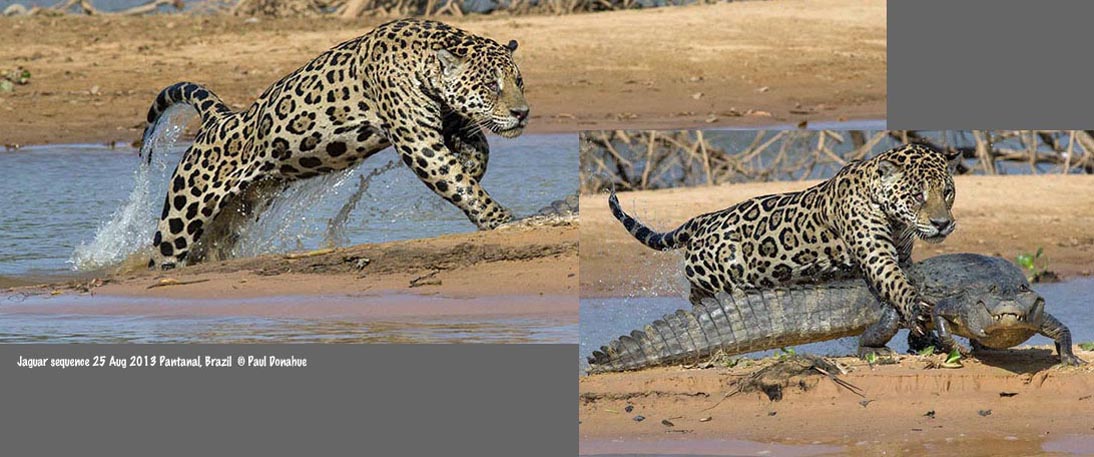 |
||||||
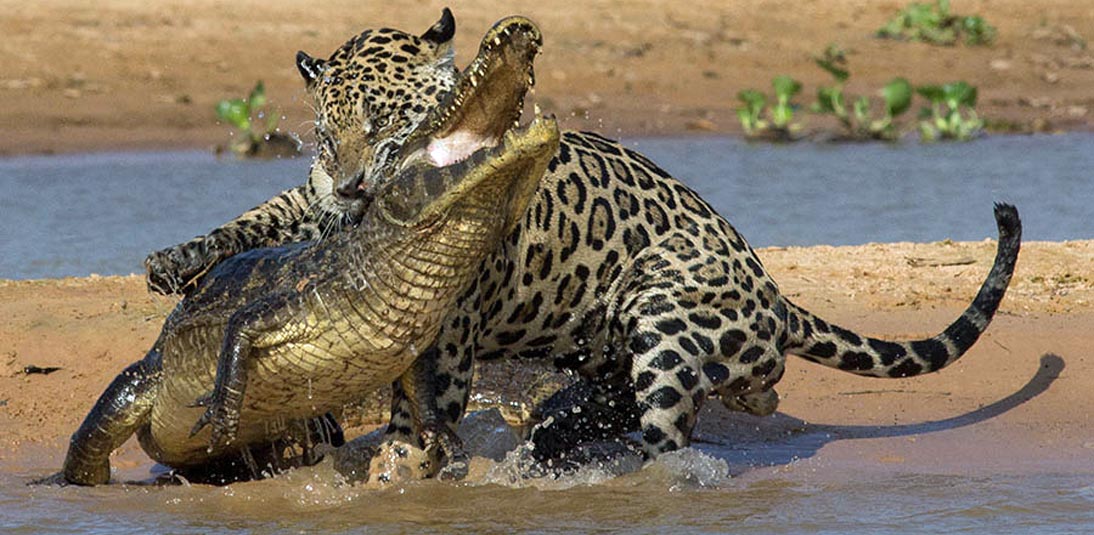 |
||||||
Jaguar attack on Yacare Caiman Caiman yacare on 25 Aug 2013 in the Pantanal, Brazil © Paul Donahue (above) |
||||||
Click below for the next page of this project OR use these LINKS to the SPECIES PAGES
|
||||||
Photos: All photos © Don Roberson, except as otherwise attributed; all rights reserved. Literature cited:
|
